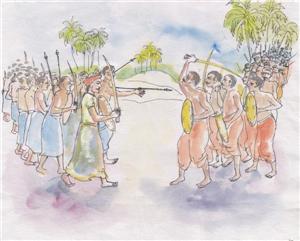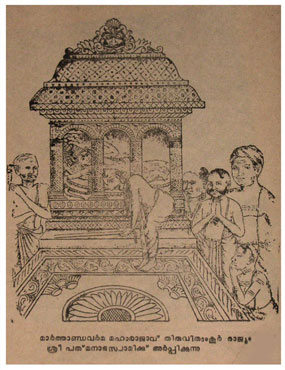The war between the English and the French for the territories for Carnatic.
The French then tightens their grip in north Kerala.
Marthanda Varma submits the country before Lord Padmanabha, his family deity.
The war raging between two hostile camps in Europe had its echo more and more in the Carnatic in south India.The English and the French who were traders in Carnatic stood with draggers drawn. With the arrival of Dupleix the position of the French became formidable. The attempts of Dupleix were to entrench at Carnatic taking advantage of the internal wars and disputes in the Carnatic. Chanda Sahib, the close ally of the French was still in the imprisonment of the Marathas. The English had their main trade centres at Madras and the French at Pondichery at the Carnatic and they carried out the trade from their respective positions and possessions, the former centering on Tellichery and the latar on Mahe. The important trade centre of the English in Travancore was at Anjengo and the French was pestered for a long time by the fact that Marthanda Varma got weapons and other help from here. The French was also embittered by the fact that not only Marthanda Varma in south Kerala but Kolathiri in north Kerala besides the Zamorin were on their attempts to establish improved ties with the English. In the meantime the failure at Kulachal and the subsequent treaty signed after it made their reliability on the wane among many kings.To retrieve the lost ground, the officials in Cochin knew, much money and more troops from Batavia were required for embroiling themselves in war. But, the Batavian government did not take in to consideration the demand from Cochin.

Purakkadu and Kayamkulam
In the meanwhile the politics of Carnatic turned upside down.The forces of Nizam drive out the Marathas from Trichinapally. Anwardeen, the new Nawab, could remain only as a mute spectator of the war raging between the powerful French and English. Incensed at the efforts of the British to rein in the growth of the French he requested Nawab to control the English who were attacking the French ships. But the Nawab's words fell on deaf ears and finally this dispute ended in the besieging of Madras by the French. Then the Nawab came in support of the English. But his order for withdrawing the siege was rejected by Dupliex. With this war broke out. This is what is called First Carnatic War (1746-1748) where the French defeated the Nawab's forces. And thus they became a supreme force in Carnatic. The English got back their possessions in Madras as a result of the treaty signed between English and the French in 1748 at the end of the Austrian War of succession. Then the English started devising strategies to root out the French in Carnatic, and a scenario was evolved where in Carnatic was going to be a battle field between the two forces. This ultimately paved the way for Second Carnatic War in 1749. It was this war that changed the course of Indian history.
As a result of the Treaty he signed with the Dutch in 1743 Marthanda Varma did not attempt for a few years major attacks. But the events unfolded during that period underscored the fact that his ambition to create the Greater Kerala by annexing neighbouring countries one by one had been still in his mind like turbulent waves. This was reflected in the invasions he launched since 1746 by which he annexed the kingdoms, Attingal, Kottarakkara, Kayamkulam, Purakkadu, Thekkumkoor, Vadakkumkoor and Meenachal to Travancore. In these battles, his power to cheat pugnacity and creative intelligence were visible. After the treaty with the Dutch, he only sent to the king of Cochin an attractive gift. But it was a strategy.

The forces of Marthanda Varma attacked Purakkadu and Kayamkulam through Karunagapally. The king of Kayamkulam took to his heels disguised and through Thekkumkoor reached Cochin and requested help from the Dutch who did not venture any help because the green flag from Batavia was not waved. After annexing Kayamkulam, Marthanda Varma tried to attack Chembakacherry (Purakkadu or Ambalapuzha) on the ground that the latter helped the former. With the seizure of Ambalappuzha the Travancore troops under De Lannoy, attacked Vadakkumkoor and Thekkumkoor. The disputes over right to succession and the internal squabbles that were strife at the neighbouring countries helped Marthanda Varma to entrench himself there once they were vanquished. Marthanda Varma watched with keenness the second Carnatic war paying heed to the emerging scenario as who was going to turn out as super power, that is whether the English or the French. Marthanda Varma held a ritualistic function in 1750 called Thrippadidanam when he dedicated to the family deity Sree Padmanabha Swami the entire Travancore territory which included the neighbouring kingdoms he annexed until then. Thrippadidanam was a ritual when the king accompanied by officials and family members came over to Sree Padmanabha Swami temple and submitted before the deity the sword drawn out from his girdle. At that time he solemnly declared that he would be later be known as the servant of Sree Padmanabha, Sree Padmanabha Dasan. His public pronouncement made it clear that he was no longer in possession of any country and he and his descendants administer Travancore belonging to Lord Sree Padmanabha, as a trustee. It attracted the attention of the public. His head quarters, the palace of Kalkulam (Padmanabhapuram palace) became the palace of Sree Padmanabha Swami. The holding of the ritual Trippadidanam might be a tactics move by Varma on the model of the strategies forged by countries in Europe in the name of religion. He knew that religion was the most powerful weapon to strengthen his grip over his subjects as well as rivals.
Before the rituals, he took steps to bring to Travancore 12000 'salagramas' from the river bed of Gandika to repair and renovate Sree Padmanabha Swamy temple and to build the gigantic reclining statue of Lord Vishnu there. When Marthanda Varma put into motion all these steps Second Anglo-French War was raging in Carnatic.
